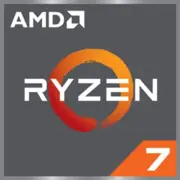AMD Ryzen 7 4700GE (OEM Only)

AMD Ryzen 7 4700GE (OEM Only): Comprehensive Review of the Processor for Compact Systems
Valid as of April 2025
1. Key Specifications: Architecture and Main Features
The AMD Ryzen 7 4700GE is an OEM solution designed for systems with limited power consumption and compact builds. Here are its key parameters:
- Architecture: Zen 2 (not to be confused with Zen 3 in Ryzen 5000).
- Process Technology: 7 nm by TSMC (FinFET).
- Cores/Threads: 8 cores, 16 threads.
- Frequency: Base — 3.1 GHz, max — 4.3 GHz (Precision Boost).
- Cache: L2 — 4 MB, L3 — 8 MB.
- TDP: 35 W.
- Integrated Graphics: Radeon Vega 8 (512 shaders, clock up to 2000 MHz).
Key Features:
- Energy Efficiency: A TDP of 35 W allows the processor to be used in mini-PCs and passive cooling systems.
- Multithreading: 16 threads handle rendering and virtualization effectively.
- Entry-level Gaming Graphics: Vega 8 can run CS:GO or Dota 2 at medium settings in Full HD.
Practical Example: Users report that combined with fast DDR4-3200, the integrated graphics deliver 15% better performance than Intel Iris Xe in the Core i7-1165G7.
2. Compatible Motherboards: Sockets and Chipsets
The processor uses the AM4 socket, which ensures compatibility with motherboards based on the following chipsets:
- B550: The best choice (supports PCIe 4.0, memory overclocking). Examples: ASUS TUF B550M-PLUS ($130), MSI B550-A PRO ($120).
- A520: Budget option without overclocking (Gigabyte A520M DS3H — $80).
- X570: For enthusiasts (e.g., ASUS ROG Strix X570-E — $250), but excessive for a 35W CPU.
Important:
- BIOS update is mandatory for boards released before 2023.
- Mini-ITX boards are suitable for compact builds, such as ASRock B550M-ITX/ac ($150).
3. Supported Memory: DDR4 and Configuration Tips
The Ryzen 7 4700GE works only with DDR4:
- Recommended Frequencies: 3200–3600 MHz (optimal for Zen 2).
- Dual-channel Mode: Essential to unleash the potential of the iGPU.
- Example Configuration: 2×16 GB DDR4-3200 CL16 (approximately $80 for the kit).
Tip: Avoid memory with latencies higher than CL18 — this can reduce gaming performance by 10–20%.
4. Power Supplies: Power Estimation
Considering the 35 W TDP and the absence of a discrete GPU:
- Minimum PSU: 400 W (e.g., be quiet! Pure Power 11 400W — $60).
- Recommendation: If an upgrade is planned (such as adding an RTX 4060-level graphics card), choose a PSU rated at 600–650 W (Corsair RM650x — $100).
Important: Even under load, a system with the 4700GE rarely consumes more than 90 W (CPU + memory + SSD).
5. Pros and Cons of the Processor
Pros:
- Energy efficiency: Ideal for 24/7 operation (e.g., home server).
- Strong multithreading: Video conversion in HandBrake on par with Ryzen 7 3700X.
- Presence of iGPU: Does not require a separate graphics card.
Cons:
- OEM status: Sold only as part of complete systems or through suppliers (price $250–300).
- Limited overclocking: Flexibility in frequency adjustments is lower than non-OEM models.
- Zen 2 architecture: Lags behind Zen 3/4 in IPC (e.g., in single-threaded tasks).
6. Use Cases: Gaming, Work, Multimedia
- Office Tasks and Multimedia: 4K streaming (Netflix, YouTube), document work.
- Casual Gaming: Fortnite (60 FPS on medium), GTA V (50–55 FPS).
- Professional Tasks: Rendering in Blender, code compilation, virtualization (VMware).
Real Example: A user built an HTPC using the 4700GE in an InWin Chopin case (volume 4.5 L) for streaming and retro gaming emulation via RetroArch.
7. Comparison with Competitors
- Intel Core i7-11700 (TDP 65 W):
- Pros: Better single-threaded performance, PCIe 4.0 support.
- Cons: Higher power consumption, more expensive ($280–320).
- AMD Ryzen 5 5600G (Zen 3):
- Pros: Newer architecture, higher IPC.
- Cons: 6 cores, weaker in multithreaded scenarios.
- Apple M2 (for comparison):
- Pros: Better energy efficiency.
- Cons: Limited compatibility with x86 software.
8. Practical Assembly Tips
- Case: Opt for compact solutions (Fractal Design Node 202, Silverstone ML09).
- Cooling: The stock cooler is sufficient, but for quiet operation, a Noctua NH-L9a ($45) will suffice.
- BIOS: Update the motherboard firmware before installation.
- Storage: Use NVMe SSDs (e.g., Samsung 980 Pro 1 TB — $120) to avoid bottlenecks.
9. Final Conclusion: Who is the Ryzen 7 4700GE Suitable For?
This processor is an ideal choice for:
1. Compact PCs: Mini-ITX builds, media centers.
2. Office Systems: Low power consumption and quiet operation.
3. Green Technology Enthusiasts: Servers based on Proxmox/TrueNAS.
4. Budget Gamers: Without investments in a discrete graphics card.
Why choose the 4700GE? It combines 8 cores, decent graphics, and unique efficiency in its class. However, if maximum performance is needed, consider the Ryzen 7 7700GE (Zen 4) or Intel Core i5-13400.
Prices are valid as of April 2025. Information is based on manufacturer data and user reviews.
Basic
CPU Specifications
Memory Specifications
GPU Specifications
Miscellaneous
Share in social media
Or Link To Us
<a href="https://cputronic.com/index.php/cpu/amd-ryzen-7-4700ge-oem-only" target="_blank">AMD Ryzen 7 4700GE (OEM Only)</a>